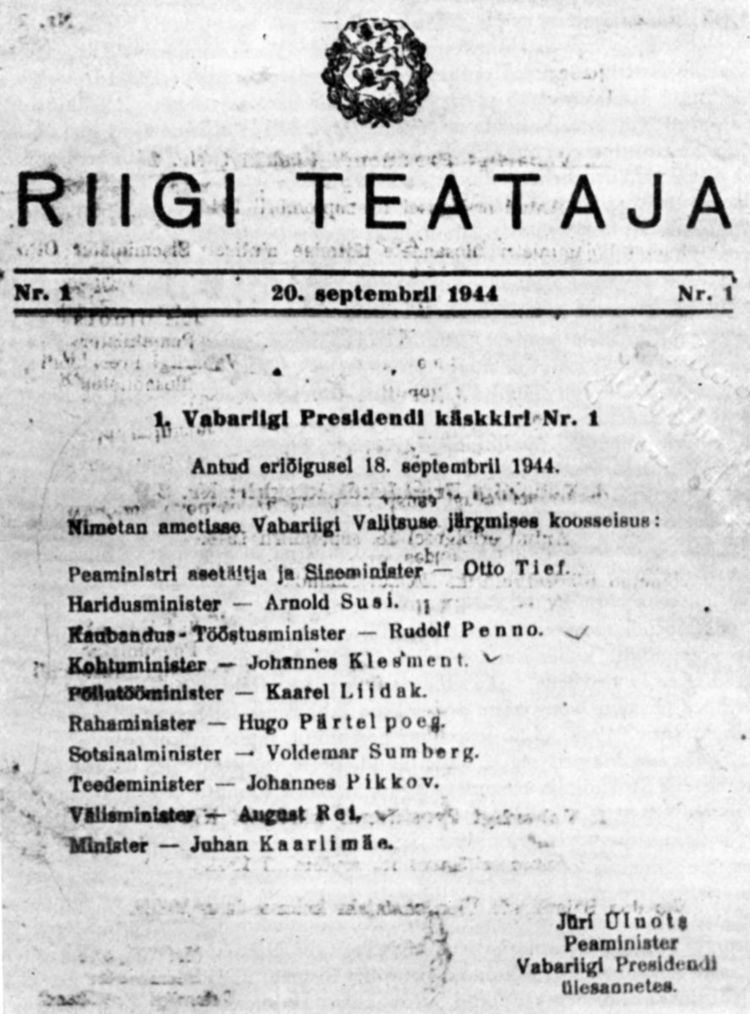 | ||
The National Committee of the Republic of Estonia (Estonian: Eesti Vabariigi Rahvuskomitee, EVRK) was formed by the underground resistance movements in German-occupied Estonia in March 1944. By April 1944 a large number of the committee members were arrested by the German security agencies.
The original initiative to form the committee came from the Estonian pre-war opposition parties but it was quickly joined by Jüri Uluots, the last constitutional pre-war Prime Minister of the Republic of Estonia and his supporters. The Committee aimed to establish of a provisional government during expected German withdrawal as the Red Army had reached the border of Estonia on February 2, 1944.
The Committee succeeded in establishing a communication network with the Estonian diplomats in Finland and Sweden.
On 20 April 1944, the National Committee selected the Electoral Committee of the Republic of Estonia (Vabariigi Presidendi Asetäitja Valimiskogu, the institution specified in the Constitution for electing the Acting President of the Republic) held a clandestine meeting in Tallinn. The participants included:
The Committee determined that the Soviet-era appointment of Johannes Vares as Prime Minister by Konstantin Päts had been illegal and that Uluots had assumed the President's duties from June 21, 1940 onwards. On 21 June 1944, Jüri Uluots appointed Otto Tief as deputy prime minister. On 18 September 1944, Uluots, suffering from cancer, named Otto Tief the Acting Prime Minister and appointed a Government which consisted of 11 members. On 20 September 1944, Uluots departed for Sweden. Tief assumed office in accordance with the constitution and took the opportunity with the departure of the Germans to declare the legitimate Estonian government restored. Most of members of this government left from Tallinn on 21 September and Tief on 22 September. As reported by the Royal Institute of International Affairs at the time: the Estonian national government was proclaimed in Estonia, the Estonian military units seized the national government buildings in Toompea Castle and ordered the German forces to leave. The flag of Germany was replaced with the flag of Estonia in the Pikk Hermann tower of Toompea. Tief’s government however failed to keep control as Estonian military units led by Johan Pitka clashed with both Germans and Soviets. On 22 September, the Soviet Leningrad Front took control of Tallinn. Most of the members and officials including Tief were caught, jailed, deported, or executed by the advancing Soviets. Tief managed to survive a decade in Siberia and after return from deportation died back in Estonia in 1976. Only Kaarel Liidak, Minister of Agriculture, died in hiding on 16 January 1945.
After Uluots died on January 9, 1945 in Sweden, August Rei, as the most senior surviving member of the government, assumed the role of acting head of state. Rei was supported by the surviving members of the Tief's government in Sweden. Rei was the last Estonian envoy in Moscow before the Soviet annexation and had managed to escape from Moscow through Riga to Stockholm in June 1940.
On 12 January 1953, the Estonian Government in Exile was established in Oslo, Norway.
